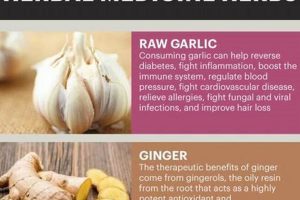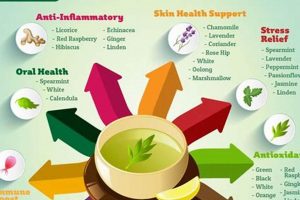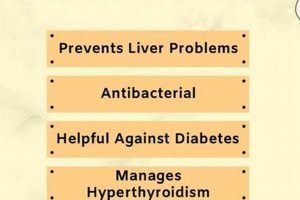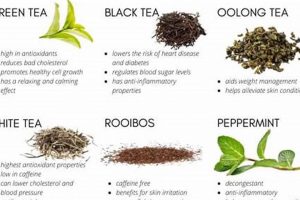The practice of using plants for medicinal purposes offers a range of potential advantages. These advantages stem from the complex chemical compounds found naturally in herbs, which can interact with the human body in various ways to promote well-being. For instance, certain plants possess anti-inflammatory properties that may alleviate pain and swelling.
Throughout history, diverse cultures have relied on botanical remedies to address health concerns. This long-standing tradition reflects an understanding of the potential of plants to support physiological functions and maintain overall health. The continued exploration and application of these traditional practices provide a valuable resource for addressing various health needs.
The following sections will explore specific examples of plant-based treatments and their applications, providing a more detailed examination of how these natural resources contribute to supporting health.
Guidance on Utilizing Plant-Based Therapeutic Approaches
To maximize the potential of plant-based therapeutic approaches, careful consideration of several key factors is essential. This guidance provides insights into responsible and informed utilization.
Tip 1: Prioritize Consultation with Qualified Professionals: Seek guidance from a licensed herbalist, naturopathic physician, or other healthcare provider with expertise in botanical medicine before initiating any regimen. Professional consultation ensures safety and appropriateness based on individual health status.
Tip 2: Emphasize Sourcing High-Quality Herbs: Acquire botanical materials from reputable suppliers who adhere to rigorous quality control standards. Verify certifications and conduct research on sourcing practices to ensure purity and potency.
Tip 3: Implement Precise Dosage and Preparation Methods: Adhere strictly to recommended dosages and preparation guidelines. Variations in preparation methods, such as infusions, decoctions, or tinctures, can significantly impact the bioavailability and efficacy of herbal remedies.
Tip 4: Recognize Potential Interactions with Conventional Medications: Understand that plant-based remedies can interact with pharmaceutical medications. A healthcare professional can assess potential interactions and adjust treatment plans accordingly.
Tip 5: Monitor Physiological Responses: Closely observe the body’s response to any new botanical remedy. Discontinue use and consult a healthcare provider if adverse effects or unexpected reactions occur.
Tip 6: Adopt a Holistic Approach to Health: Integrate plant-based therapeutic approaches as part of a comprehensive health and wellness plan. This plan should encompass proper nutrition, regular exercise, stress management, and sufficient rest.
Tip 7: Conduct Thorough Research: Engage in ongoing education regarding the properties, applications, and potential risks of various plant-based remedies. Consult credible sources and peer-reviewed research to make informed decisions.
Adherence to these guidelines promotes the safe and effective integration of botanical therapeutic approaches into a holistic health strategy. Diligent adherence to quality standards and professional guidance is crucial.
The following sections will offer a conclusion to this discussion on the subject, synthesizing key points and reinforcing the importance of responsible implementation.
1. Symptom alleviation
Symptom alleviation represents a significant aspect of the potential benefits derived from botanical interventions. The capacity of plant-derived compounds to mitigate specific symptoms contributes directly to the overall perception of improved health and well-being. Understanding the nuances of this symptom management is crucial for evaluating the role of herbal therapy.
- Pain Reduction
Many botanical agents possess analgesic and anti-inflammatory properties. For example, willow bark, containing salicin (a precursor to aspirin), has been traditionally employed to reduce pain associated with headaches and arthritis. The targeted reduction of pain can enhance mobility and improve daily functioning.
- Gastrointestinal Relief
Herbal remedies frequently address digestive discomfort. Ginger, for instance, has demonstrated efficacy in alleviating nausea and reducing indigestion. Peppermint oil is also used for Irritable Bowel Syndrome (IBS) by reducing spasms and gas. Reduction in gastrointestinal disturbances directly enhances nutrient absorption and comfort.
- Improved Sleep Quality
Certain botanicals exhibit sedative properties, fostering relaxation and promoting sleep. Valerian root and chamomile are often used to alleviate insomnia and reduce anxiety, leading to improved sleep patterns. Better sleep quality impacts cognitive function, mood, and overall physical health.
- Respiratory Support
Herbal interventions can offer relief from respiratory ailments. Eucalyptus oil, known for its decongestant properties, aids in clearing airways and alleviating coughs associated with colds and respiratory infections. This symptomatic relief supports easier breathing and improved respiratory function.
The utilization of botanical remedies for symptom alleviation, as demonstrated through these examples, underscores a key dimension of the potential advantages associated with plant-based therapeutic approaches. While not curative, such symptom management significantly impacts quality of life and warrants consideration within a comprehensive health management strategy.
2. Holistic wellness support
Holistic wellness support, as it relates to the use of plant-based therapies, encompasses a philosophy that extends beyond merely treating isolated symptoms. This approach emphasizes the interconnectedness of physical, mental, and emotional well-being, positioning botanical remedies as tools to support overall systemic balance. The integration of plant-based treatments within a holistic framework seeks to address underlying imbalances rather than solely targeting surface-level manifestations.
- Adaptogenic Influence on Stress Response
Adaptogens, a class of herbs such as Ashwagandha and Rhodiola, modulate the body’s response to stress. These botanicals do not simply mask symptoms; instead, they work to normalize physiological processes affected by stress, including hormonal regulation and immune function. Their use promotes resilience, enabling the body to adapt more effectively to stressors, thereby impacting long-term well-being.
- Digestive Health and Nutrient Absorption
The gut microbiome plays a central role in overall health. Herbal interventions, such as the use of prebiotic herbs or those with mild antimicrobial properties, can support a balanced gut environment, enhancing nutrient absorption and immune function. This support, in turn, affects energy levels, mental clarity, and the body’s ability to defend against pathogens.
- Emotional Well-being and Nervine Action
Certain plant-derived compounds, categorized as nervines, exert a calming influence on the nervous system. Herbs such as lavender and lemon balm can reduce anxiety and promote relaxation without causing significant sedation. By fostering a state of calm, these remedies support emotional equilibrium and contribute to mental clarity.
- Detoxification and Elimination Processes
Herbal remedies can facilitate the body’s natural detoxification pathways. Diuretic herbs like dandelion and liver-supporting herbs such as milk thistle promote the elimination of waste products and toxins. Supporting these processes can enhance liver function, improve skin health, and reduce the overall burden on the body’s systems.
These facets of holistic wellness support demonstrate that plant-based interventions extend beyond simple symptom management. By addressing interconnected systems and supporting fundamental physiological processes, botanical remedies can play a role in promoting comprehensive well-being. This perspective emphasizes the importance of considering the whole person when integrating plant-based approaches into health management strategies.
3. Chronic Condition Management
Chronic condition management represents a critical area where plant-based therapies may offer considerable benefits. These conditions, characterized by their long duration and often gradual progression, frequently require multifaceted management strategies that extend beyond acute symptom relief. Herbal interventions, when appropriately integrated, can serve as valuable adjuncts to conventional medical treatments in mitigating disease progression and improving quality of life.
For example, in the management of type 2 diabetes, certain herbs, such as Gymnema sylvestre, have demonstrated an ability to improve insulin sensitivity and lower blood glucose levels. While not a replacement for insulin or other pharmaceutical interventions when necessary, their inclusion may help to manage blood sugar fluctuations more effectively. Similarly, individuals with osteoarthritis may experience pain relief and improved joint function through the use of anti-inflammatory herbs like turmeric (curcumin), potentially reducing the need for long-term reliance on non-steroidal anti-inflammatory drugs (NSAIDs) and their associated gastrointestinal risks.
The significance of herbal therapy in chronic condition management lies in its potential to address the underlying physiological imbalances that contribute to disease progression. Furthermore, the holistic nature of many herbal approaches encourages a focus on lifestyle factors such as diet and stress management, which are integral to effective long-term care. However, challenges remain, including the need for rigorous clinical research to validate efficacy and ensure safety, as well as the importance of qualified healthcare professionals guiding their use. In conclusion, while not a panacea, the strategic and informed application of plant-based therapies holds promise in enhancing chronic condition management strategies.
4. Preventative healthcare role
The employment of plant-derived remedies extends beyond acute symptom management and chronic condition mitigation, encompassing a significant role in preventative healthcare strategies. This preventative application aims to bolster the body’s natural defenses, reduce the risk of developing specific ailments, and promote overall resilience.
- Immune System Modulation
Certain botanical agents possess immunomodulatory properties, capable of enhancing immune function. Echinacea, for instance, is frequently used to stimulate immune cell activity, potentially reducing the incidence and severity of upper respiratory tract infections. This proactive approach to immune support can be particularly beneficial during periods of increased susceptibility to illness.
- Cardiovascular Health Support
Plant-based interventions can contribute to the maintenance of cardiovascular health by addressing key risk factors. Garlic, for example, has demonstrated an ability to lower blood pressure and cholesterol levels. Incorporating such remedies into a preventative regimen may reduce the likelihood of developing cardiovascular disease.
- Antioxidant Protection
Many herbs and spices are rich in antioxidants, which neutralize free radicals and protect cells from oxidative damage. Turmeric, green tea, and berries are examples of antioxidant-rich botanicals that can contribute to overall health and reduce the risk of chronic diseases associated with oxidative stress. Consistent intake of these antioxidants supports long-term cellular integrity.
- Digestive Health Maintenance
The gut microbiome plays a crucial role in overall health, and plant-based remedies can support a balanced gut environment. Probiotic-rich foods and herbs that promote digestive enzyme production can enhance nutrient absorption, reduce inflammation, and support immune function. Maintaining optimal digestive health through preventative measures contributes to overall well-being.
These facets of preventative healthcare highlight the diverse applications of plant-based remedies in supporting long-term health and reducing the risk of disease. By addressing key physiological systems and promoting resilience, herbal interventions can play a valuable role in a comprehensive preventative healthcare strategy. The potential advantages extend beyond symptom management, fostering overall well-being and potentially reducing the burden of chronic diseases.
5. Improved Quality of Life
The relationship between botanical remedies and an elevated quality of life is multifaceted, extending beyond the mere alleviation of physical symptoms. Plant-based therapeutic approaches contribute to an enhanced quality of life by addressing physical, mental, and emotional dimensions of well-being. The impact is observed through increased functionality, reduced reliance on conventional pharmaceuticals with potential side effects, and an overall sense of empowerment in managing one’s health. For instance, individuals managing chronic pain with herbal anti-inflammatories may experience improved mobility and reduced dependence on opioid analgesics, fostering a more active and fulfilling lifestyle.
Furthermore, the incorporation of traditional herbal practices into daily routines often promotes a heightened awareness of one’s body and its needs. This increased self-awareness can lead to proactive lifestyle modifications, such as improved dietary habits and stress management techniques, further contributing to a sense of well-being. The accessibility and affordability of many plant-based remedies can also empower individuals in underserved communities to take control of their health, leading to improvements in both physical and mental health outcomes. For example, community herbalism initiatives that focus on educating individuals about locally available medicinal plants can foster a sense of agency and resilience in the face of health challenges.
In summary, botanical remedies play a role in enhancing an individual’s quality of life by addressing physical ailments, promoting mental and emotional balance, and fostering a sense of self-efficacy. The synergistic effects of these factors contribute to improved daily functioning, reduced reliance on conventional medications, and a greater sense of empowerment in managing one’s health. Understanding the nuances of this relationship underscores the importance of integrating evidence-based herbal practices into comprehensive healthcare strategies, tailored to the specific needs and circumstances of each individual.
6. Accessibility and Affordability
The extent to which plant-based remedies are available and financially attainable significantly influences their overall utility. When botanical therapies are readily accessible and affordable, a broader segment of the population can potentially benefit from their therapeutic properties. This widespread availability fosters greater self-reliance in healthcare management, particularly among individuals with limited access to conventional medical services. The cost-effectiveness of certain herbal interventions, compared to pharmaceutical alternatives, can be especially relevant for those managing chronic conditions on a fixed income. This affordability allows for continued treatment without incurring substantial financial strain, contributing to improved adherence and potentially better health outcomes.
Accessibility extends beyond financial considerations to encompass geographic availability and the ease of acquiring relevant knowledge. For instance, in many rural communities, locally grown or foraged herbs represent the primary source of healthcare. Educational initiatives that empower individuals to identify, cultivate, and utilize these resources sustainably enhance community resilience and self-sufficiency. Conversely, the presence of regulatory barriers, such as restrictive licensing requirements or import restrictions, can impede access to certain herbal remedies, particularly those sourced from international markets. Addressing these barriers requires a multi-faceted approach that balances consumer safety with the promotion of equitable access.
The interplay between accessibility, affordability, and the potential health advantages of plant-based therapies underscores the need for policies that support both consumer access and product quality. By ensuring that safe and effective herbal remedies are readily available at reasonable prices, healthcare systems can empower individuals to take a more active role in managing their own well-being. This proactive approach not only reduces healthcare costs but also fosters a greater sense of personal agency and self-reliance within communities. The long-term implications of this approach include improved health outcomes and a reduction in healthcare disparities, particularly among vulnerable populations.
Frequently Asked Questions Regarding Plant-Based Therapeutic Approaches
The following section addresses common inquiries concerning the utilization of botanical remedies in health management. It is intended to provide a concise and informative overview.
Question 1: What constitutes the primary mechanism of action for botanical remedies?
Botanical remedies exert influence through complex chemical compounds that interact with various physiological systems. These interactions can modulate inflammation, support immune function, and influence neurotransmitter activity, among other mechanisms. The specific mode of action varies depending on the plant species and its constituent compounds.
Question 2: Are plant-based therapies subject to regulatory oversight?
Regulatory oversight of plant-based therapies differs across jurisdictions. In some regions, botanical remedies are regulated as dietary supplements, while others impose stricter pharmaceutical-grade standards. It is imperative to consult local regulations and verify product quality through third-party certifications when available.
Question 3: How should individuals determine appropriate dosages for botanical remedies?
Appropriate dosages for botanical remedies depend on multiple factors, including age, body weight, health status, and the specific herb in question. Consultation with a qualified healthcare professional or licensed herbalist is essential to determine safe and effective dosages tailored to individual needs.
Question 4: What are the potential risks associated with plant-based therapies?
Plant-based therapies can pose potential risks, including allergic reactions, interactions with conventional medications, and adverse effects on specific organ systems. Individuals with pre-existing health conditions or those taking prescription drugs should exercise caution and seek professional guidance prior to initiating herbal treatment.
Question 5: Can plant-based therapies be used as a substitute for conventional medical treatment?
Plant-based therapies should not be used as a substitute for conventional medical treatment in cases of serious or life-threatening conditions. While botanical remedies can serve as valuable adjuncts to conventional care, they are not appropriate for managing acute medical emergencies or replacing essential pharmaceutical interventions.
Question 6: How can individuals assess the quality and purity of botanical products?
Assessment of quality and purity involves verifying third-party certifications, reviewing sourcing practices, and inspecting product labels for accurate ingredient information. Reputable manufacturers often conduct rigorous testing to ensure that their products are free from contaminants and adulterants.
In summary, the utilization of botanical remedies necessitates careful consideration of regulatory guidelines, dosage protocols, potential risks, and product quality. Consultation with qualified healthcare professionals is crucial to ensure safe and effective integration of plant-based therapies into a comprehensive health management strategy.
The subsequent section will offer a concluding perspective on the role of plant-based therapeutic approaches in contemporary healthcare.
Conclusion
This article has explored various facets of using plants for their therapeutic properties, detailing specific advantages. From the alleviation of symptoms and the support of holistic wellness to their role in managing chronic conditions and offering preventative healthcare options, the potential of these interventions is evident. Factors such as improved quality of life and increased accessibility further underscore the importance of integrating plant-based approaches into healthcare strategies.
The informed and responsible utilization of botanical remedies necessitates careful consideration of their mechanisms, potential risks, and appropriate dosages, ideally guided by qualified healthcare professionals. As research continues to unveil the intricacies of plant-human interactions, a more refined understanding of their therapeutic capabilities will emerge, paving the way for evidence-based applications that complement conventional medical practices.







